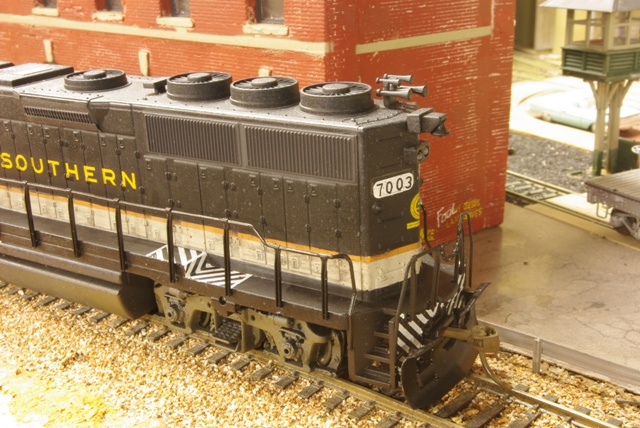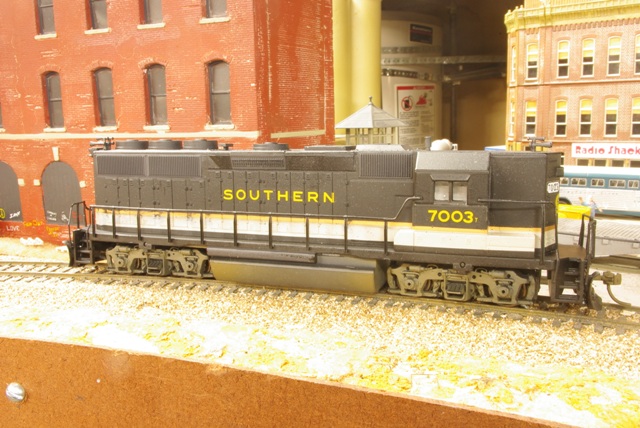Here's my unit with decal work in progress:

The low-numbered units had black-on-white numberboards to indicate they were LocoTrol masters. The Micro Scale sheet had 7003 as a single number, and I had some Shell Scale black-on-white numbers, so it was a logical choice.
Posts: 5,263
Threads: 195
Joined: Apr 2009
jwb Wrote:Here's my unit with decal work in progress:...
The low-numbered units had black-on-white numberboards to indicate they were LocoTrol masters. The Micro Scale sheet had 7003 as a single number, and I had some Shell Scale black-on-white numbers, so it was a logical choice. Your engine looks good! I did not fix the decals with dull coat. Your engine shows the difference of the numbers. I will replace mine at the cab when the micro scale arrive.
I did notice the black-on-white numbers at the low numbers but did not know why. Thanks for the explanation :tad a:
How did you remove the "southern" at the long hood? Did you find a chemical solution? I am afraid a mechanical solution may do harm to the doors and latches.
Do you have an explanation why Bachmann made some SOU GP50 with 9xxx road numbers? I could not find any prototype. Was there a renumbering I did not notice?
Reinhard
I used some sort of paint remover for plastics, Floquil or Scalecoat or whatever it was. It had been sitting in an old coffee jar, so I don't have the label. I used a cotton swab and brushed it over the lettering, but it was hard to control, and it either sat there for a long time and didn't do anything, or it suddenly ate through the base paint as well. That was why I had to mask off the tuxedo and repaint the body with Engine Black to get things uniform again, but now I have to touch up the bleedthrough on the tuxedo.
I have no idea why Bachmann did them in the 9000s. They kept the 7000 numbers into NS. If you have your NS unit in hand, could you post a good photo? I'd like to see how close it is to the prototype lettering, since for $30 I really don't want to go through that paint work again!
During the 1980s I was working at various places where I had to pass over the LA River and the UP tracks on the East Bank on my commute, and I frequently saw SOU/NS units running through on the UP. I think you can easily justify these units in LA, but it sounds like you sometimes extend your conceptual territory into the Southeast anyhow. I agree that even without flywheels, these are good-running units, and a little paint and decal work does a lot for them.
Posts: 854
Threads: 52
Joined: Nov 2009
faraway Wrote:torikoos Wrote:...I have an Athearn RTR SW1500,... Koos, I have a bunch of the current Athearn RTR SW1500 (not the old blue box units). They are great runners without any modifications with ZIMO (preferred) and ESU (some hum) decoders. I did never do any modifications to the PCB etc. other than cutting off the 9-pin decoder cable and plugging my decoder into the 8-pin plug.
Hmmm, I have to have another good look at my SW1500, which is currently equiped with a TCS T4X decoder, previously had a NCE decoder (forgot the model at the moment). It looks like the build in auto BEMF function of the TCS decoder does not like whatever it's getting as feedback from my motor/drivetrain.... it starts very slow but not smooth, then accellerates, but past a certain threshold it suddenly accellerates much more. Slowing down is better. I've tried loads of settings with both decoders I've tried. As said, I will have another look at the mechanics, and then perhaps try yet another decoder....
Koos
Be sure to visit my model railroad blog at <!-- m --><a class="postlink" href="http://www.namrr.blogspot.com">http://www.namrr.blogspot.com</a><!-- m -->
Posts: 5,263
Threads: 195
Joined: Apr 2009
jab Wrote:...If you have your NS unit in hand, could you post a good photo? I'd like to see how close it is to the prototype lettering, ...
Here we go
Side and front. Couplers and snow plow added, horns and bell painted black, handrail painted yellow. Everything else is pure Bachmann:
![[Image: 6ab9b1bf.jpg?t=1343167268]](http://i966.photobucket.com/albums/ae149/faraway52/Misc-1/6ab9b1bf.jpg?t=1343167268)
![[Image: d298f9a9.jpg?t=1343167275]](http://i966.photobucket.com/albums/ae149/faraway52/Misc-1/d298f9a9.jpg?t=1343167275)
And details of the front and side lettering:
![[Image: 624243ad.jpg?t=1343167279]](http://i966.photobucket.com/albums/ae149/faraway52/Misc-1/624243ad.jpg?t=1343167279)
![[Image: 64d832a8.jpg?t=1343167283]](http://i966.photobucket.com/albums/ae149/faraway52/Misc-1/64d832a8.jpg?t=1343167283)
ps. This is the "DCC unit" that differs in some internal details from our SOU "DC unit".
Reinhard
Posts: 5,263
Threads: 195
Joined: Apr 2009
torikoos Wrote:...my SW1500, which is currently equiped with a TCS T4X decoder, previously had a NCE decoder ...
I think both decoders are very wide used in the US. You should find any known problems in the decoder / engine combination in various forums. Can you test with an SW1500 of a local friend?
Reinhard
Posts: 2,458
Threads: 57
Joined: Dec 2008
torikoos
"Hmmm, I have to have another good look at my SW1500, which is currently equiped with a TCS T4X decoder, previously had a NCE decoder (forgot the model at the moment). It looks like the build in auto BEMF function of the TCS decoder does not like whatever it's getting as feedback from my motor/drivetrain.... it starts very slow but not smooth, then accellerates, but past a certain threshold it suddenly accellerates much more. Slowing down is better. I've tried loads of settings with both decoders I've tried. As said, I will have another look at the mechanics, and then perhaps try yet another decoder...."
Koos...You might want to check if BEMF can be disabled. I know that in the D'trax decoders I use it can be disabled. It's one of those good ideas that has yet to be well implemented.
Gus (LC&P).
Posts: 854
Threads: 52
Joined: Nov 2009
Hi Reinhard,
I can probably test with a local friend, however I have tested it with several decoders, and none give me good slow speed performance, which is what I want from it. I think I will dismantle the drive train once more to have a good look, check for RF surpression RC circuits, and if all else fails, get another decoder to try. (I have tried the decoders in other locos and after setting up, they do work fairly well).
Gus, yes BEMF can be disabled on the T4X. In this situation, another method can be used, which is dithering with various amplitude and/or frequency. I've also tried that, and the low speed performance is still not great then.
I don't want to hijack this thread any further, as this is supposed to be about bachmann Geeps, not my decoder issues, so I'll post elsewhere once I've found the solution.
Thanks for your suggestions,
Koos
Be sure to visit my model railroad blog at <!-- m --><a class="postlink" href="http://www.namrr.blogspot.com">http://www.namrr.blogspot.com</a><!-- m -->
Posts: 5,263
Threads: 195
Joined: Apr 2009
Another remark on Bachmann's GP50 is about lubrication.
The gear wheels and the worm gear are lubricated very well. But the axles of the gear are almost without any lubrication. I suggest to:
1. remove the button cover of the trucks and lube the tiny ends of the gear wheels running in the plastic housing
2. shift the worm gear to each side and oil the axis of the worm gear in the brass bearing
That simple procedure reduced residual noise on two of my machines significant.
Koos, I see. In that case I would try to find and remove the RFI components too. I would not disable BEMF of the decoder. I find that the most valuable function of DCC at all.
Reinhard
Here's my finished Bachmann GP50 as Southern 7003. All I did was lube the motor and drive train, use paint remover for plastics to remove the road name and number lettering, weather the chassis, mask off the gray band and repaint the rest of the body Engine Black, carve off the cast-on handrail and lift lever on the pilot, add decals, modify the coupler pockets for Kadee long-shank scale heads, and add plows. Without a flywheel, it's still an adequate runner for switching, though GP50s were meant mostly for intermodal. The new striping and lettering distract attention from the major detail issues.
I'm still making up my mind whether I want to do more of these.



On one hand, it's a $30 loco. On the other hand, it's more than a week of evenings/afternoons to get it to an acceptable state.
Posts: 5,263
Threads: 195
Joined: Apr 2009
The new paint, weathering and decals are very good!
You did not paint the handrails at the steps yellow. I assumed that was mandatory around 1980 when the GP50 were delivered and I did see it on all photos. Problem is that the yellow paint emphasize the poor quality of the handrails.
Reinhard
Not only that, but it'll flake off.
Posts: 80
Threads: 9
Joined: Jul 2011
THANK YOU faraway and everybody else for the excellent and useful information! I am currently working on a Bachmann S-4 DC version I eventually would like to make DCC with sound. These inexpensive locomotive models seem to be outstanding platforms for customization. Y'all already know about the slot car paint for slippery plastic no doubt. The really old Athearn Blue Box GP shells are too wide, but they are so old now you may not encounter one. The Bachmann shells are very nice scale. That is a very good finish on the Espee GP-7's; also on the Southern GP-50! The decoder information in this thread is very useful and valuable. Thanks again! Ric
Posts: 262
Threads: 6
Joined: Aug 2012
jwb Wrote:Not only that, but it'll flake off.
I have had good results by using matt white enamel paint (Humbrol) as a primer on the handrails. So far no flaking on the ten or locos I've done.
Cheers,
Kev
Such is life
Posts: 1,639
Threads: 87
Joined: Dec 2008
Quick question for our Bachmann GP50 pros. :mrgreen: I have one of these that I think is straight DC but I am not sure .If it is it will need a decoder.The thing is I bought it used from a local LHS .
It runs great but I have no documentation for it.The one I need to know is how do I remove the body from the chassis.I realize by looking at it I could most likely figure it out BUT it's packed away for the time being and I don't really want to take the time to go find it . 
Johnathan (Catt) Edwards
"The Ol Furrball"
"I'm old school,I still believe in respect"
|
 The low-numbered units had black-on-white numberboards to indicate they were LocoTrol masters. The Micro Scale sheet had 7003 as a single number, and I had some Shell Scale black-on-white numbers, so it was a logical choice.
The low-numbered units had black-on-white numberboards to indicate they were LocoTrol masters. The Micro Scale sheet had 7003 as a single number, and I had some Shell Scale black-on-white numbers, so it was a logical choice.




![[Image: 6ab9b1bf.jpg?t=1343167268]](http://i966.photobucket.com/albums/ae149/faraway52/Misc-1/6ab9b1bf.jpg?t=1343167268)
![[Image: d298f9a9.jpg?t=1343167275]](http://i966.photobucket.com/albums/ae149/faraway52/Misc-1/d298f9a9.jpg?t=1343167275)
![[Image: 624243ad.jpg?t=1343167279]](http://i966.photobucket.com/albums/ae149/faraway52/Misc-1/624243ad.jpg?t=1343167279)
![[Image: 64d832a8.jpg?t=1343167283]](http://i966.photobucket.com/albums/ae149/faraway52/Misc-1/64d832a8.jpg?t=1343167283)

